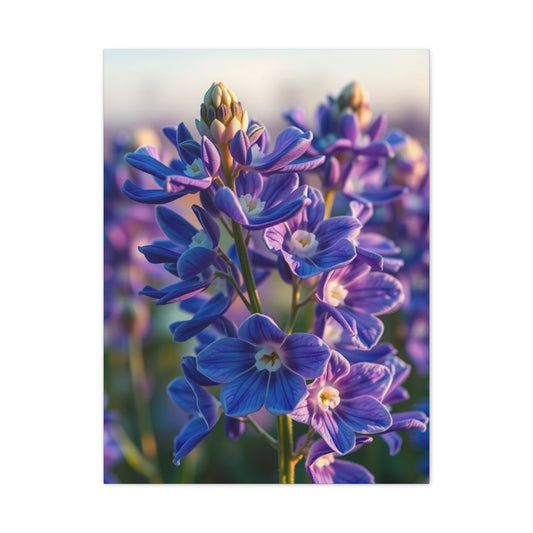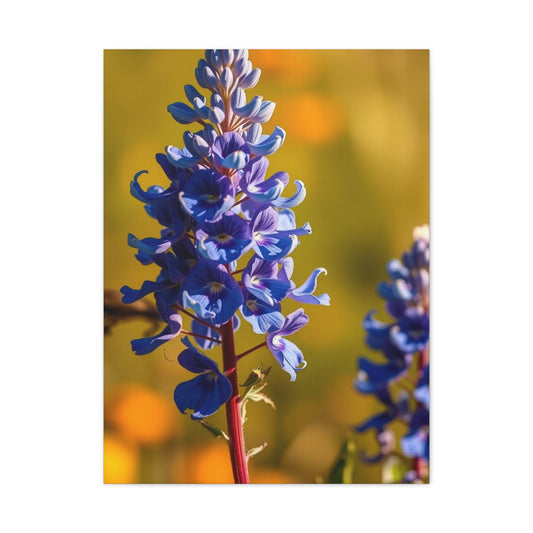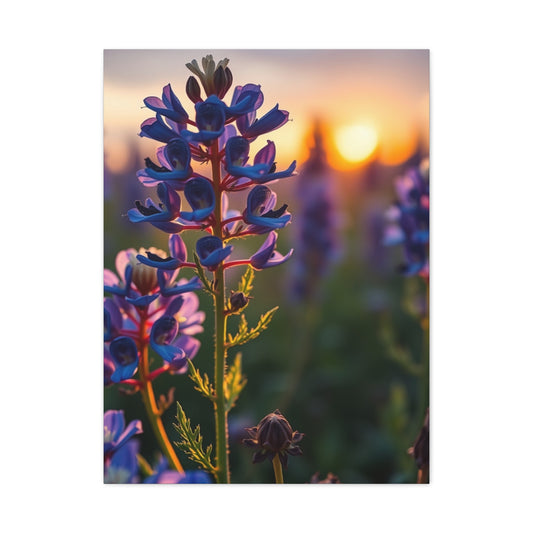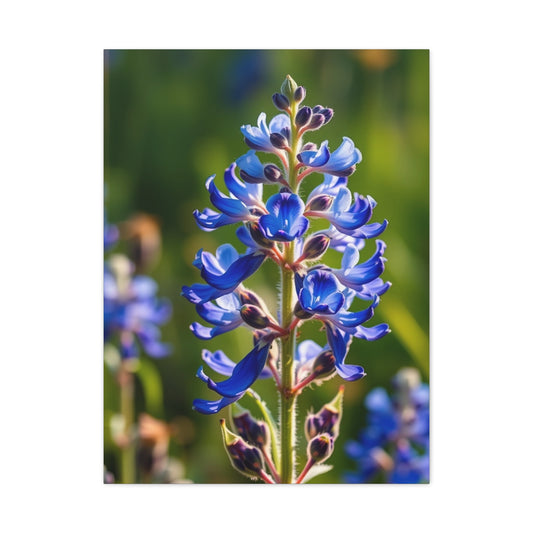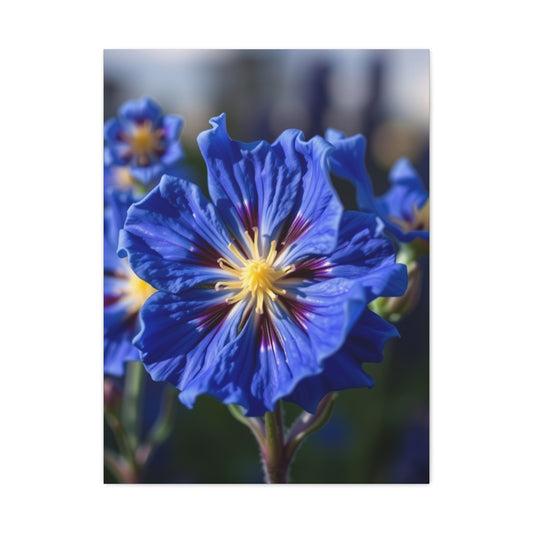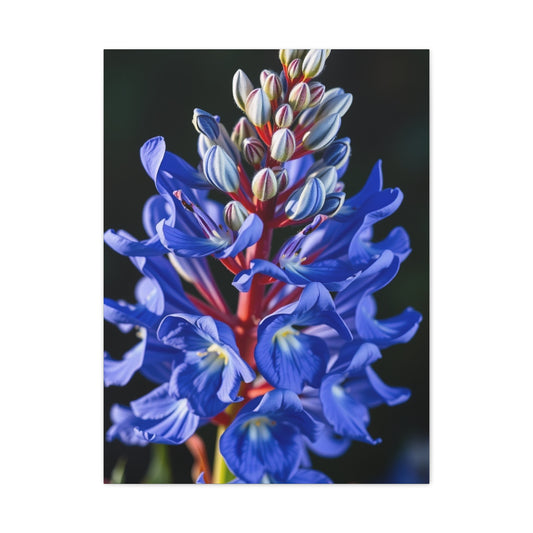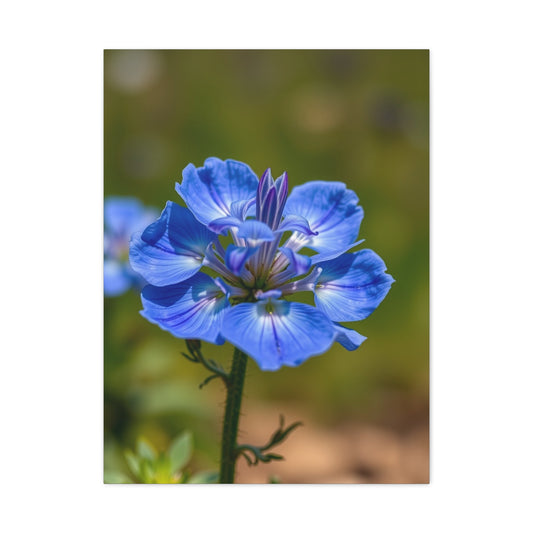Complete Guide to Creating Stunning Bluebonnet Flower Wall Art
Creating magnificent bluebonnet flower wall art represents one of the most rewarding artistic endeavors for both novice and experienced painters alike. These iconic Texas wildflowers, with their vibrant blue-violet hues, delicate petals, and slender, elegant spikes, have long inspired artists, nature enthusiasts, and interior designers. Their unique coloration, ranging from deep indigo to soft lavender, provides a versatile palette that can harmonize effortlessly with a variety of décor styles, from rustic farmhouse interiors to contemporary minimalist spaces. Capturing the essence of bluebonnets on canvas allows artists to celebrate the arrival of spring, the renewal of life, and the timeless charm of the Texas landscape.
The process of creating bluebonnet wall art begins with understanding the flower’s intricate structure. Each bloom consists of clusters of small, symmetrical petals that gradually form a conical spike. Paying close attention to this natural geometry is crucial for achieving a realistic and visually captivating composition. Artists often choose to study real-life bluebonnet fields or reference high-resolution photographs to accurately depict variations in color, shading, and the interplay of light across the petals. These studies serve as the foundation for translating the delicate beauty of bluebonnets onto a larger canvas, ensuring that the artwork feels both authentic and enchanting.
Beyond technical accuracy, bluebonnet wall art provides endless creative opportunities. Painters can experiment with different styles, from hyper-realistic depictions that celebrate every minute detail to impressionistic interpretations that focus on the play of light, color, and movement. Layering techniques, such as glazing or dry brushing, can enhance the depth and vibrancy of each bloom, while thoughtful use of background textures—like subtle washes of sky blue or gentle hints of surrounding greenery—can create a sense of spatial dimension and atmosphere.
Understanding Bluebonnet Characteristics and Visual Properties
Before embarking on your bluebonnet painting journey, developing a thorough understanding of these remarkable flowers proves essential for achieving authentic results. Bluebonnets possess unique structural characteristics that distinguish them from other wildflowers. Their distinctive flower spikes rise gracefully from silvery-green foliage, creating natural pyramidal shapes that add vertical interest to any composition.
The color palette of bluebonnets extends far beyond simple blue tones. These flowers exhibit subtle variations ranging from deep indigo at the base of each spike to lighter periwinkle tones in the middle sections, culminating in pristine white caps that crown each flower cluster. This natural progression from dark to light creates an inherent sense of depth and dimension that skilled artists can exploit to create visually compelling artwork.
Understanding the growth patterns of bluebonnets also contributes significantly to creating believable compositions. These flowers typically grow in irregular clusters rather than uniform rows, creating organic patterns that lead the eye naturally through the landscape. Some areas feature dense concentrations of blooms, while others show scattered individual plants interspersed with native grasses and other vegetation.
Essential Materials and Tools for Bluebonnet Painting
Selecting appropriate materials forms the foundation of successful bluebonnet artwork. Oil paints offer particular advantages for capturing the subtle color variations and smooth blending capabilities necessary for realistic flower rendering. However, acrylic paints can also produce excellent results when handled with proper techniques and understanding of their unique properties.
For oil painting enthusiasts, essential pigments include Ultramarine Blue as the primary blue foundation, supplemented by Indanthrene Blue for deeper, more intense passages. Adding violet tones requires Dioxine Purple, Permanent Rose, or Alizarin Crimson, depending on the specific color temperature desired. Titanium White proves indispensable for creating the characteristic white caps that distinguish bluebonnet flowers.
Brush selection plays a crucial role in achieving various textures and effects throughout your bluebonnet composition. Flat bristle brushes excel for blocking in large areas and creating smooth color transitions. Round brushes provide precision for detailed flower work and fine linear elements. Fan brushes, particularly older ones with slightly separated bristles, prove invaluable for creating grass textures and organic patterns that complement bluebonnet masses.
Canvas preparation requires careful consideration of surface texture and priming. Medium-texture canvases work well for bluebonnet subjects, providing enough tooth to hold paint layers while remaining smooth enough for detailed work. Proper priming ensures paint adhesion and prevents color absorption that could dull the vibrant blues characteristic of these flowers.
Compositional Planning and Design Principles
Successful bluebonnet paintings begin with thoughtful compositional planning that considers both aesthetic principles and natural growth patterns. Creating compelling compositions requires understanding how bluebonnets naturally occur in their native environment and translating those observations into artistic arrangements that guide viewer attention effectively.
Establishing a clear focal point within your bluebonnet composition proves essential for creating visual impact. This might involve concentrating the densest flower masses in strategic locations, using color intensity variations to create emphasis, or employing overlapping forms to suggest depth and spatial relationships. The rule of thirds provides an excellent framework for positioning key elements within your composition.
Creating effective visual pathways through bluebonnet arrangements requires careful consideration of how flower masses connect and flow throughout the composition. Avoiding rigid, unnatural lines while maintaining clear directional movement challenges artists to balance spontaneity with intentional design. Studying photographs and direct observation of bluebonnet fields provides invaluable reference material for understanding natural growth patterns.
Incorporating complementary landscape elements enhances bluebonnet compositions significantly. Native Texas vegetation such as Indian paintbrush, evening primrose, and various grass species creates authentic environmental context. Adding trees, rocks, hills, and sky elements provides compositional anchors and establishes proper scale relationships within the overall design.
Color Theory and Mixing Techniques for Bluebonnets
Mastering color relationships proves fundamental to creating convincing bluebonnet representations. These flowers present unique challenges due to their complex color variations and the need to maintain chromatic harmony throughout the composition while avoiding monotonous repetition.
Understanding warm and cool color relationships within blue families allows artists to create more dynamic and visually interesting bluebonnet masses. Cooler blues work effectively for flowers in shadow areas or those positioned in the background, while warmer blue-violet mixtures suit foreground flowers receiving direct sunlight. This temperature variation creates natural atmospheric perspective that enhances spatial depth.
Creating effective color mixtures for bluebonnets requires experimentation and practice. Beginning with Ultramarine Blue as a foundation, artists can modify this base color by adding small amounts of violet, red, or even subtle green tones to achieve specific effects. The key lies in maintaining the overall blue character while introducing enough variation to prevent flatness.
White cap representation demands particular attention to color temperature and placement. Pure white rarely appears in nature, so mixing slightly warm or cool whites depending on lighting conditions creates more realistic effects. These white areas should follow the natural flower structure, typically appearing at the tips of flower spikes and creating the characteristic bluebonnet silhouette.
Value relationships within bluebonnet masses require careful orchestration to achieve convincing depth and form. Establishing clear patterns of light, medium, and dark values helps define individual flower clusters while maintaining overall compositional unity. This value structure provides the foundation upon which color relationships can be built effectively.
Background Preparation and Environmental Context
Creating appropriate backgrounds for bluebonnet subjects involves understanding their natural habitat and translating environmental characteristics into supportive compositional elements. Texas landscapes typically feature rolling hills, scattered trees, rocky outcroppings, and expansive skies that provide dramatic backdrops for wildflower displays.
Sky treatment deserves special consideration in bluebonnet compositions, as these flowers often appear against dramatic cloud formations during peak blooming season. Understanding cloud structure and form proves essential for creating believable atmospheric conditions. Clouds possess three-dimensional qualities with definite light and shadow areas that must be rendered convincingly to support the overall composition.
Establishing proper atmospheric perspective throughout background elements helps create spatial depth and focuses attention on foreground bluebonnet masses. Distant hills should exhibit cooler colors and softer edges, while foreground elements maintain warmer temperatures and sharper definition. This gradual transition creates convincing depth without competing with primary flower subjects.
Incorporating native Texas vegetation into background areas adds authenticity and visual interest to bluebonnet compositions. Understanding the growth habits and seasonal characteristics of plants like mesquite, live oak, prickly pear cactus, and various native grasses provides opportunities for creating rich, detailed environments that support the main flower subjects.
Ground plane treatment requires careful attention to create believable settings for bluebonnet growth. These flowers typically emerge from grassland environments, so understanding grass textures, color variations, and growth patterns proves essential. Using fan brushes and other texture-creating tools helps establish convincing ground surfaces that appear natural rather than artificial.
Initial Underpainting Techniques and Value Establishment
Beginning your bluebonnet painting with a solid underpainting strategy establishes the fundamental structure upon which all subsequent layers will be built. This crucial stage determines the overall success of your finished artwork, so taking time to plan and execute this phase carefully pays dividends throughout the painting process.
Establishing accurate value relationships during the underpainting stage provides the foundation for all subsequent color applications. Working in monochromatic tones allows artists to focus purely on light and shadow patterns without the distraction of color relationships. This approach ensures that the fundamental structure remains sound regardless of color choices made in later stages.
Blocking in major shape relationships during the underpainting phase helps establish proper proportional relationships throughout the composition. Identifying the largest shapes first, then progressively subdividing them into smaller elements creates a logical painting sequence that maintains overall unity while allowing for detailed development in later stages.
Creating effective texture foundations during underpainting requires understanding how different brushwork techniques translate into surface qualities. Grass areas benefit from directional brushstrokes that suggest growth patterns, while flower masses require more varied application methods that accommodate the complex forms of individual blooms and clusters.
Working from general to specific during the underpainting stage prevents getting caught up in premature detail that might compromise overall compositional relationships. Maintaining focus on large pattern relationships while resisting the temptation to render individual flowers ensures that the painting develops systematically and cohesively.
Detailed Bluebonnet Rendering Techniques
Transitioning from underpainting to detailed bluebonnet rendering requires shifting focus from broad pattern relationships to specific flower characteristics while maintaining overall compositional integrity. This phase demands careful observation and systematic approach to avoid overwhelming complexity that could compromise the painting's effectiveness.
Understanding bluebonnet flower structure proves essential for convincing representation. Each flower spike consists of numerous individual blooms arranged in a specific pattern that creates the characteristic conical shape. These individual flowers progress from deep blue-violet at the base through lighter blue tones in the middle sections to white caps at the tips.
Developing effective brushwork techniques for flower rendering requires practice and experimentation. Small, confident strokes work well for indicating individual blooms, while larger strokes help establish overall flower mass shapes. Varying stroke directions and sizes creates visual interest while maintaining the natural randomness characteristic of wildflower growth.
Creating convincing depth within flower masses involves careful manipulation of color temperature, value, and edge quality. Flowers positioned deeper within masses should appear slightly cooler and darker than those at the surface, while edge treatment should vary from sharp, crisp definition for prominent flowers to softer, less defined edges for those that recede into the composition.
Avoiding overworking bluebonnet areas requires discipline and clear artistic vision. The temptation to render every flower in precise detail often leads to tight, lifeless results that lack the spontaneous quality characteristic of successful wildflower paintings. Suggesting detail through selective rendering proves more effective than attempting comprehensive representation.
Advanced Color Mixing and Temperature Control
Sophisticated bluebonnet rendering demands advanced understanding of color relationships and temperature control that goes beyond basic color theory. These skills allow artists to create subtle variations that bring life and authenticity to flower representations while maintaining overall compositional harmony.
Exploring subtle color variations within blue families opens possibilities for creating more interesting and dynamic bluebonnet masses. Adding tiny amounts of complementary colors such as orange or yellow can neutralize overly intense blues while creating more natural-looking color relationships. These modifications should remain subtle to preserve the essential blue character of the flowers.
Managing color temperature transitions throughout bluebonnet areas helps create convincing light and atmosphere effects. Flowers receiving direct sunlight should exhibit slightly warmer blue tones, while those in shadow areas benefit from cooler color applications. This temperature variation mimics natural light behavior and enhances the three-dimensional quality of flower masses.
Creating effective color gradations within individual flower spikes requires careful planning and execution. The natural progression from dark base colors through middle tones to white caps provides opportunities for demonstrating advanced color control skills. These transitions should appear seamless and natural rather than mechanical or forced.
Understanding how surrounding colors influence bluebonnet appearance proves crucial for maintaining color harmony throughout the composition. Green foliage, brown earth tones, and sky colors all affect how blue tones are perceived, requiring artists to adjust their mixtures accordingly to achieve desired visual effects.
Texture Creation and Surface Variation Techniques
Developing convincing surface textures throughout bluebonnet compositions requires understanding various application techniques and their appropriate uses. Different areas of the painting demand different textural approaches to create believable material qualities and maintain visual interest throughout the composition.
Grass texture creation benefits from directional brushwork that follows natural growth patterns. Using fan brushes with separated bristles allows artists to create convincing grass effects that provide appropriate foundations for bluebonnet masses. Varying stroke lengths, directions, and pressures creates natural randomness while maintaining overall directional flow.
Rock surface rendering requires understanding basic geological principles and light behavior on mineral surfaces. Rocks possess distinct planes that catch light differently, creating clear value relationships that define form and suggest material qualities. Studying actual rock formations provides invaluable reference material for creating convincing representations.
Tree bark textures demand specific techniques that suggest the linear, vertical quality characteristic of oak and mesquite trees common in bluebonnet habitats. Using liner brushes and palette knives can create convincing bark effects that add authenticity to landscape elements without overwhelming the primary flower subjects.
Cloud surface treatment requires understanding atmospheric conditions and light behavior in sky environments. Clouds possess definite form and structure with clear light and shadow relationships that must be rendered convincingly to support overall compositional believability. Soft brush techniques work well for creating appropriate cloud textures.
Light and Shadow Manipulation
Mastering light and shadow relationships proves fundamental to creating convincing bluebonnet paintings that exhibit proper three-dimensional qualities and atmospheric effects. Understanding how natural light behaves in outdoor environments provides the foundation for all successful landscape painting endeavors.
Establishing consistent light source direction throughout the composition ensures visual coherence and believability. Once the primary light direction is determined, all elements within the painting must conform to this lighting scheme to maintain consistency. This includes flower masses, foliage, rocks, trees, and all other compositional elements.
Creating effective shadow shapes within bluebonnet areas requires understanding how complex flower structures interact with directional lighting. Shadow patterns should follow natural flower arrangements while contributing to overall compositional design goals. These shadows provide opportunities for introducing cooler color temperatures and creating visual contrast.
Managing reflected light effects adds sophistication to bluebonnet representations. Light reflected from surrounding surfaces influences shadow areas, often introducing subtle warm tones that prevent shadows from appearing dead or lifeless. Understanding these reflected light phenomena helps create more convincing and visually appealing results.
Controlling edge quality relationships between light and shadow areas contributes significantly to overall painting effectiveness. Sharp, crisp edges suggest direct, strong lighting, while softer transitions indicate more diffused atmospheric conditions. Varying edge quality throughout the composition creates visual interest while supporting the desired mood and atmosphere.
Atmospheric Perspective and Depth Creation
Creating convincing spatial depth in bluebonnet landscapes requires understanding atmospheric perspective principles and their practical application in painting situations. These techniques help establish proper scale relationships and guide viewer attention through carefully orchestrated visual pathways.
Color temperature progression from warm foreground areas to cooler background elements creates natural atmospheric effects that enhance spatial depth perception. Bluebonnet masses positioned in foreground areas should exhibit warmer blue-violet tones, while distant flower areas benefit from cooler, more neutral color applications.
Value contrast manipulation provides another powerful tool for creating spatial depth in bluebonnet compositions. Foreground elements should exhibit stronger value contrasts between light and shadow areas, while background elements display more compressed value relationships that suggest atmospheric filtering effects.
Edge quality progression from sharp foreground definition to softer background treatment reinforces spatial depth while creating visual hierarchy within the composition. This technique prevents background elements from competing with primary subjects while maintaining overall compositional interest and believability.
Scale relationship management ensures that all compositional elements appear to exist within the same spatial environment. Bluebonnet flowers positioned in background areas should appear appropriately smaller than foreground specimens, while maintaining proper proportional relationships with surrounding environmental elements.
Compositional Refinement and Visual Flow
Developing sophisticated compositional skills allows artists to create bluebonnet paintings that guide viewer attention effectively while maintaining visual interest throughout the entire picture surface. These advanced design principles separate successful artwork from merely competent technical exercises.
Creating effective visual pathways through bluebonnet arrangements requires careful manipulation of shape, color, and value relationships. These pathways should lead viewer attention through the composition in a logical sequence that explores all important areas while returning focus to primary subject matter.
Managing repetition and variation within flower masses prevents monotonous results while maintaining overall unity. Varying flower sizes, colors, orientations, and spacing creates natural randomness that mimics actual wildflower growth patterns. This variation should remain subtle enough to preserve compositional harmony.
Establishing proper focal hierarchy ensures that primary subjects receive appropriate emphasis while supporting elements remain subordinate. This might involve concentrating the most intense colors, strongest value contrasts, or sharpest edges within focal areas while reducing these qualities in less important compositional regions.
Balancing complexity and simplicity throughout the composition creates visual interest without overwhelming viewers. Areas of detailed rendering should be balanced by simpler passages that provide visual rest and prevent sensory overload. This balance varies depending on painting size, viewing distance, and artistic goals.
Advanced Brushwork and Application Techniques
Developing sophisticated brush handling skills enables artists to create varied surface qualities and expressive effects that enhance bluebonnet representations significantly. These technical abilities provide the tools necessary for translating artistic vision into physical paint applications.
Varying brushstroke character throughout different areas of the composition creates appropriate textural relationships while maintaining overall coherence. Smooth, flowing strokes work well for sky areas and distant elements, while more energetic, varied applications suit foreground vegetation and detailed flower work.
Loading brushes with multiple colors simultaneously creates natural color variations within single strokes, mimicking the complex color relationships found in natural flower subjects. This technique reduces the mechanical appearance that results from overly systematic color application approaches.
Controlling paint consistency throughout the painting process affects both surface quality and color behavior. Thicker applications create textural interest and catch light effectively, while thinner applications allow for smooth color transitions and atmospheric effects. Understanding when to employ each approach proves crucial for achieving desired results.
Managing paint layer relationships prevents muddy colors while allowing for effective color modification and correction. Understanding fat-over-lean principles in oil painting ensures proper paint adhesion and prevents future cracking or other technical problems that could compromise artwork longevity.
Problem-Solving and Correction Techniques
Even experienced artists encounter challenges during the bluebonnet painting process that require effective problem-solving strategies and correction techniques. Developing these skills prevents minor issues from becoming major obstacles that compromise overall painting success.
Addressing color problems requires understanding their underlying causes and appropriate correction methods. Muddy colors often result from overmixing or using too many different pigments simultaneously. Correcting these issues might involve scraping away problematic areas and repainting with cleaner color mixtures.
Resolving compositional problems sometimes requires significant modifications to existing work. Being willing to sacrifice completed areas for overall painting improvement demonstrates artistic maturity and commitment to quality results. Planning correction strategies before implementation prevents creating additional problems.
Managing paint consistency issues throughout the painting process requires understanding how different mediums affect paint behavior. Adding appropriate solvents or mediums can restore workability to paint that has become too thick or difficult to manipulate effectively.
Correcting drawing problems that become apparent during painting stages might require structural modifications to established compositional elements. Understanding when such corrections are necessary versus when alternative solutions might prove more effective requires developed artistic judgment and experience.
Finishing Techniques and Final Refinements
Completing successful bluebonnet paintings requires understanding when to stop working and how to execute final refinements that enhance overall effectiveness without overworking previous accomplishments. These final stages often determine the difference between good and exceptional artwork.
Evaluating overall compositional relationships provides guidance for final adjustment decisions. Standing back from the painting and viewing it from appropriate distances reveals relationships that remain invisible during close working distances. This perspective helps identify areas requiring final attention.
Making selective accent additions can enhance focal areas and create sparkle throughout the composition. These might include small touches of pure color, sharp edge definition, or subtle value adjustments that increase visual impact without disrupting established relationships.
Harmonizing color relationships throughout the entire composition ensures overall unity while maintaining necessary variety. This might involve glazing selected areas with thin, transparent colors that tie different sections together or modify relationships that appear discordant.
Finalizing surface qualities throughout different areas of the painting ensures appropriate textural relationships and prevents any sections from appearing unfinished or inconsistent with overall painting character. This attention to surface unity contributes significantly to professional-appearing results.
Exhibition Preparation and Presentation Considerations
Preparing completed bluebonnet paintings for exhibition or display requires understanding presentation options and their effects on viewer perception. Proper framing, lighting, and positioning enhance artwork effectiveness while protecting the physical painting from environmental damage.
Frame selection should complement the painting character without competing for attention. Traditional gold frames work well with realistic bluebonnet landscapes, while contemporary frames suit more impressionistic or abstract interpretations. The frame should enhance rather than dominate the artwork.
Matting considerations for works on paper require understanding how different mat colors and textures affect color perception within the artwork. Neutral colors typically work best for preserving color relationships, while colored mats should be used judiciously to avoid unwanted color interactions.
Lighting requirements for oil paintings differ from those for other media due to surface reflectance characteristics. Avoiding direct lighting that creates glare while ensuring adequate illumination for proper color appreciation requires careful positioning and light source selection.
Protecting completed artwork from environmental damage involves understanding appropriate storage, handling, and display conditions. Temperature and humidity control, UV protection, and proper handling procedures preserve artwork condition and ensure longevity for future enjoyment.
Teaching and Sharing Bluebonnet Painting Techniques
Sharing bluebonnet painting knowledge with others provides opportunities for artistic growth while contributing to the broader artistic community. Developing teaching skills and creating instructional materials extends artistic influence beyond personal creative endeavors.
Organizing instructional content requires understanding learning sequences and skill development progressions. Beginning with fundamental concepts and building complexity gradually ensures student success while preventing overwhelming beginners with advanced techniques they are not prepared to handle effectively.
Demonstrating techniques effectively requires clear communication skills and understanding of common learning obstacles. Anticipating student questions and preparing appropriate responses contributes significantly to instructional effectiveness and student satisfaction with learning experiences.
Creating reference materials such as color mixing charts, technique demonstrations, and step-by-step progressions provides valuable resources for students to reference during independent practice sessions. These materials extend instructional impact beyond formal class time.
Building supportive learning environments encourages artistic risk-taking and creative exploration while maintaining focus on skill development goals. Balancing encouragement with constructive criticism helps students develop both technical abilities and artistic confidence.
Seasonal Considerations and Plein Air Painting
Understanding seasonal timing for bluebonnet blooming provides opportunities for direct observation and plein air painting experiences that enhance studio work quality significantly. These field experiences provide authentic color and lighting reference that photographs cannot fully capture.
Preparing for outdoor painting sessions requires understanding equipment needs, weather considerations, and safety factors that affect field painting success. Portable easels, appropriate paint transport systems, and weather protection ensure productive outdoor painting experiences.
Managing changing lighting conditions during outdoor painting sessions requires adaptive strategies and efficient working methods. Understanding how light changes throughout the day helps artists plan work sessions and make necessary adjustments to maintain consistent lighting effects.
Capturing authentic atmospheric conditions through direct observation provides reference material that enhances studio painting accuracy and authenticity. Recording specific weather conditions, light quality, and seasonal characteristics creates valuable reference resources for future studio work.
Translating outdoor observations into studio paintings requires understanding the differences between field studies and finished artwork. Field studies serve as reference material rather than finished paintings, providing color notes, compositional ideas, and atmospheric observations for studio development.
Digital Tools and Photography for Reference
Incorporating digital photography into bluebonnet painting preparation provides valuable reference resources while avoiding complete dependence on photographic sources. Understanding how to use photographs effectively enhances painting accuracy without constraining creative interpretation.
Camera settings for wildflower photography require understanding depth of field, color accuracy, and composition principles that translate effectively to painting applications. Proper exposure techniques ensure accurate color recording that serves as reliable reference material.
Organizing reference photographs systematically creates accessible resources for future painting projects. Digital cataloging systems allow artists to locate specific reference material efficiently while building comprehensive resource libraries for ongoing use.
Understanding photographic limitations prevents over-reliance on reference materials that might constrain creative interpretation. Photographs cannot capture the full range of color and value relationships visible to human vision, requiring artists to interpret and enhance photographic reference material.
Combining multiple reference sources creates more comprehensive understanding of subject matter than single photographs can provide. Using various viewpoints, lighting conditions, and seasonal timing expands available reference material and creative possibilities.
Historical and Cultural Significance of Bluebonnets
Understanding the cultural importance of bluebonnets in Texas heritage adds depth and meaning to artistic interpretations of these beloved flowers. This historical context can inform artistic choices and enhance personal connection to the subject matter.
Bluebonnets achieved official state flower status through legislation that recognized their significance to Texas identity and natural heritage. This designation reflects the deep cultural connection between these flowers and regional pride that continues to influence contemporary artistic expression.
Native American cultural traditions associated with bluebonnets provide historical context that predates European settlement. Understanding these traditional relationships adds cultural depth to contemporary artistic interpretations while respecting indigenous heritage and knowledge.
Agricultural and ecological relationships between bluebonnets and Texas landscapes reveal complex environmental interactions that affect flower distribution and abundance. This understanding can inform artistic choices regarding appropriate environmental settings and companion plantings.
Contemporary conservation efforts to preserve bluebonnet habitats reflect ongoing cultural commitment to maintaining these iconic landscapes for future generations. Artists can contribute to these conservation efforts by creating artwork that celebrates and promotes appreciation for native wildflower environments.
Environmental Awareness and Conservation Through Art
Creating bluebonnet artwork provides opportunities for promoting environmental awareness and supporting conservation efforts that protect native wildflower habitats. Art serves as a powerful communication tool for environmental messages that reach audiences beyond traditional conservation communities.
Understanding habitat requirements and threats facing bluebonnet populations informs artistic choices while raising awareness about environmental challenges. Climate change, habitat loss, and invasive species represent ongoing threats that art can help communicate to broader audiences.
Supporting conservation organizations through artistic contributions extends creative influence beyond aesthetic appreciation to practical environmental protection efforts. Donating artwork for fundraising events or creating commissioned pieces for conservation purposes provides tangible support for habitat protection.
Educational outreach through artistic programs combines creative expression with environmental education to reach diverse audiences with conservation messages. School programs, community workshops, and public demonstrations can increase both artistic appreciation and environmental awareness.
Sustainable art practices demonstrate environmental commitment through material choices, transportation decisions, and waste reduction strategies. These practices align artistic activities with conservation values while providing examples for other artists to follow.
Business Aspects of Bluebonnet Art
Developing sustainable approaches to marketing and selling bluebonnet artwork requires understanding target audiences, pricing strategies, and business practices that support ongoing artistic careers. These business skills enable artists to share their work while maintaining financial sustainability.
Identifying target markets for bluebonnet artwork involves understanding who appreciates this subject matter and how to reach these audiences effectively. Texas residents, wildflower enthusiasts, and landscape art collectors represent potential market segments with different needs and preferences.
Pricing strategies should reflect both artistic quality and market realities while ensuring fair compensation for time and skill investments. Understanding comparable artwork pricing helps establish appropriate price ranges while allowing for quality and reputation differences.
Marketing approaches for wildflower artwork might include online galleries, local exhibitions, art festivals, and specialty markets that attract appropriate audiences. Building relationships with collectors, interior designers, and commercial clients creates ongoing opportunities for sales and commissions.
Building professional relationships within the art community provides opportunities for exhibitions, collaborations, and referrals that extend market reach beyond individual promotional efforts. These relationships often prove more valuable than formal marketing strategies for career development.
Conclusion
Creating stunning bluebonnet flower wall art represents a journey that combines technical skill development with artistic vision and deep appreciation for one of nature's most beloved wildflowers. Throughout this comprehensive exploration, we have examined every aspect of the painting process, from understanding the unique characteristics of bluebonnets to mastering advanced techniques for their realistic representation.
The journey of painting bluebonnets begins with careful observation and understanding of these remarkable flowers in their natural environment. Their distinctive blue-violet coloration, crowned with pristine white caps, creates natural beauty that has inspired artists for generations. Learning to see and interpret the subtle color variations, growth patterns, and environmental relationships of bluebonnets forms the foundation upon which all successful artwork is built.
Technical mastery emerges through systematic practice of fundamental skills including color mixing, brushwork, and compositional design. Understanding how Ultramarine Blue, Indanthrene Blue, and violet pigments can be combined to create the full range of bluebonnet colors enables artists to capture the authentic appearance of these flowers. Developing confident brushwork techniques allows for both broad, impressionistic effects and detailed, realistic rendering as artistic vision demands.
Compositional skills prove equally important for creating artwork that guides viewer attention effectively while celebrating the natural beauty of bluebonnet landscapes. Understanding how to arrange flower masses, incorporate environmental elements, and manage visual pathways creates paintings that engage viewers and communicate the artist's intended message. These design principles separate successful artwork from mere technical exercises.
The importance of understanding natural lighting conditions and atmospheric effects cannot be overstated in bluebonnet painting. Texas landscapes provide dramatic skies, rolling hills, and diverse vegetation that create perfect backdrops for wildflower displays. Learning to render these environmental elements convincingly while maintaining focus on the flower subjects requires developed observation skills and technical proficiency.
Advanced techniques such as atmospheric perspective, color temperature control, and sophisticated brushwork enable artists to create paintings that exhibit professional quality and lasting appeal. These skills develop through consistent practice and willingness to challenge oneself with increasingly complex subjects and artistic goals. The investment in skill development pays dividends throughout an artist's career.
Understanding the cultural and environmental significance of bluebonnets adds depth and meaning to artistic interpretation. These flowers represent not only natural beauty but also cultural heritage, environmental health, and seasonal renewal that resonates deeply with viewers familiar with Texas landscapes. Artists who understand these deeper meanings can create work that connects with audiences on emotional as well as aesthetic levels.
The business aspects of creating and sharing bluebonnet artwork provide opportunities for artists to build sustainable careers while celebrating these beloved flowers. Understanding target markets, pricing strategies, and promotional approaches enables artists to reach appropriate audiences while maintaining artistic integrity and financial stability.
Conservation awareness and environmental responsibility align naturally with bluebonnet painting, as artists who celebrate natural beauty often become advocates for habitat protection and environmental stewardship. Art serves as a powerful communication tool for conservation messages while providing economic incentives for habitat preservation.
Teaching and sharing bluebonnet painting techniques extends artistic influence beyond personal creative endeavors to impact the broader artistic community. Developing instructional skills and creating educational resources contributes to the continuation of traditional painting techniques while inspiring new generations of artists to appreciate and interpret natural subjects.
The integration of traditional painting techniques with contemporary tools and approaches creates exciting possibilities for bluebonnet art development. Digital photography, color theory advances, and improved art materials enable today's artists to achieve effects that previous generations could only imagine. However, fundamental skills of observation, interpretation, and technical execution remain as important as ever.
Seasonal awareness and plein air painting opportunities provide authentic experiences that enhance studio work quality significantly. Direct observation of bluebonnets in their natural environment creates understanding that photographs cannot fully convey, leading to more authentic and compelling artistic interpretations.
Personal artistic development through bluebonnet painting extends beyond technical skill acquisition to include aesthetic sensibility, creative confidence, and deeper appreciation for natural beauty. These personal benefits enrich life experience while providing foundation for continued artistic growth and exploration.

